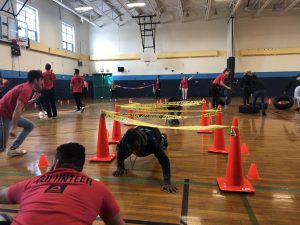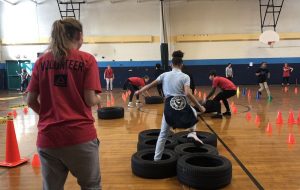Top Tips for Implementing Obstacle Courses
06/25/19

Obstacle courses are a BOKS favorite for so many reasons. They’re super versatile and customizable, great for both indoor and outdoor spaces, and don’t require any special equipment. As the weather improves and the best place for exercise is outside, building an obstacle course is a great way for kids to improve endurance, strength, and cardiovascular health.
For a beginner, obstacle courses may be intimidating at first. Where do you set the obstacle course up? How will I get my group of all ages to run through it?
For the obstacle course aficionado, you may still run into questions about engaging every age group in the same course or changing things up when obstacles no longer pose as much of a challenge. BOKS is here to answer all your questions and offer some obstacle course tips and tricks.
Set-Up:

The first step to setting up an obstacle course is to assess the area you’ll be using. If you’re setting up indoors, try to get creative with the path you set the obstacle course to! From the obstacle course master himself, trainer Frank DeAngelis from Thomas Hamilton School:
“When we’re forced inside the gym, we’ll do a spiral starting at the outside and moving closer and closer into the middle. We’ll also utilize our entrance and exit, having the kids start going in one door, have them do the course (maze-like) and have them end at out opposite door and run out and around the hallway.”
Taking the obstacle course outside may give you more room, as well as using hills or a playground as part of the challenge.
Stations:
Pick out how many stations you want in your obstacle course – try starting with 4 to 5 and you can build on the course from there. Larger courses may include more stations, or just increase the length between stations to build cardio strength.
Next, choose what you want your stations to be. This is the fun part, where you can work in a skill-of-the-week you’ve been practicing.
For ideas on what to include, check out our FREE obstacle course pack, where you can find some BOKS-curated picks. Some of our favorite stations include:
- Log Rolls
- Jumping over “fire”
- Bear Crawls
- Water Bottle Flipping
Volunteers:

One of the most important components of an obstacle course is having volunteers to help you set up, monitor, and demonstrate the stations. Ideally, 2-4 additional parents or teachers should help with set up and running the course. Volunteers are important not only for assisting with set up, but they can also act as trainers while kids are running through the stations – making it easier for you to monitor all the kids!
To prepare for the volunteers, make sure you have a plan for the course, either printed out or drawn by hand. At the very least, make sure they’re familiar with how the course will be set up and how many kids will be going through.
Spicing things Up
Now, if you’ve mastered obstacle courses, “spicing them up” may be your biggest challenge. There’s only so many times you can run back-and-forth and jump over cones.
DeAngelis added his obstacle courses, “evolved with a lot of trial and error, seeing what the kids like to do, and working that in with what the kids needed to do as far as building their skill level.”
Some tips include:
- Incorporate team work into your obstacle courses. For example passing a ball “over under” style.
- Making sure to emphasize finishing as a team will help each kids to help look out for one another and can be a critical skill they take
- Time the kids as they go through the obstacle course. This can be a great way to keep things interesting and fun, as well as build stamina and team work.

Adding balls and ball-passing to obstacle course can add a level of difficulty. - You can time the group that goes through, split your class up into small groups and time each of them, or time individuals to see if they can break their own records. This is a great way to keep an obstacle course interesting for older kids that are running through the same course as younger ones.
- Be creative with the materials you use! You don’t need anything fancy to create an awesome obstacle course. Use cones and string/rope/tape to create hurdles or obstacles to crawl under or recycle old water bottles for bottle flipping!
- Incorporate class skills that that you’ve been learning into the course. For example, if you’ve been working on balance, create a “balance beam” for the students to walk across as one of the stations.
Key Takeaways
Obstacle courses are a great way to switch things up if a class is getting used to the same material each day. They can challenge kids on strength, speed, and endurance, and it really lets the kids burn off some extra energy while practicing BOKS skills of the week and other exercises they’ve learned.

Additionally, obstacle courses can have a great, lasting impact on kids by inspiring them to continue to challenge their skills on all levels. Obstacle courses can teach them the importance of collaboration, and always looking out for your fellow teammates as they go through the course.
Remember, the only thing holding you back is your own creativity!

